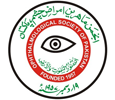ISSN 0886-3067



Volume No 39 Issue No 3
Clinical Characteristics of Horizontal Strabismus in Sudanese Patients
Purpose: To describe clinical characteristics of horizontal strabismus in Sudanese patients. Study Design: A retrospective chart review (RCR), a hospital-based study. Place and Duration of Study: Al-Neelain Eye Hospital, Khartoum, Sudan, from January 2017 to May 2021. Methods: There were 773 patients, who presented with horizontal strabismus. Data regarding demographics and eye examination including visual acuity, refractive error, and angle of deviation, type of strabismus (intermittent, constant, or alternating)were collected. Data analysis was done by SPSS 23, and statistical significance was set at P< 0.05. Results: The commonest strabismus was esotropia 522(71.5%). There were 415(56.8%) females. Most patients had alternating strabismus 436(59.7%), followed by constant strabismus 206(28.2%). Vision differed by types of strabismus (P =0.032) with worse vision found in esotropia(mean, 0.69±0.34)compared to exotropia (mean, 0.78±0.33). Refractive error varied by types of strabismus. Hyperopia was common with esotropia (mean, +3.9±3.8 D) and myopia was associated with exotropia (-3.4±2.8 D). The main cause of horizontal strabismus was congenital and presence of refractive error. Hyperopia was a major cause of esotropia for children aged 6 – 10 years which was highly significant (P <0.003) and myopia was the primary reason for exotropia at ?15 years (P =0.485). Conclusion: The most common type of strabismus among Sudanese was esotropia. Causes of strabismus differed by age group with refractive error and congenital disorders accounting for most of the children aged less than six years and myopia for the majority of exotropia aged more than15 years.
HTML Full Text | Complete PDF